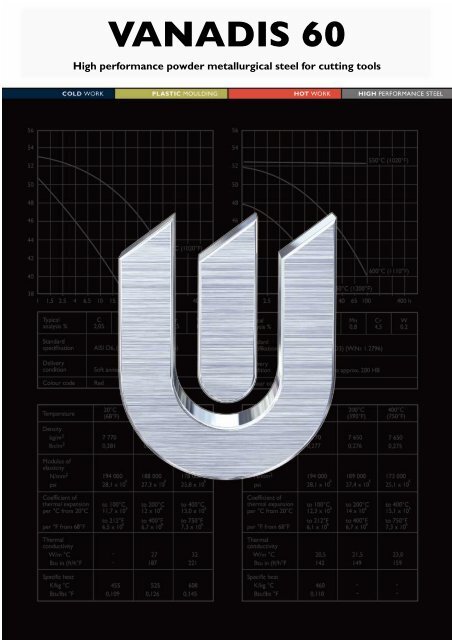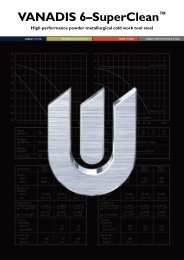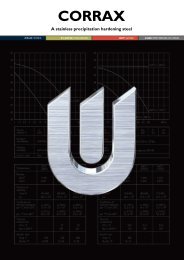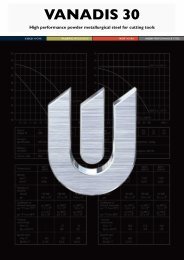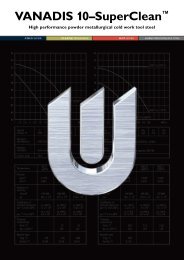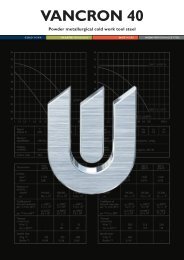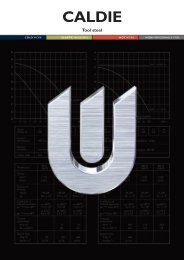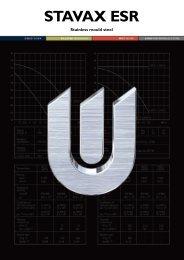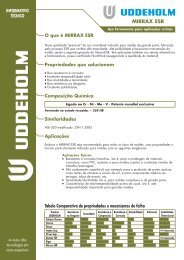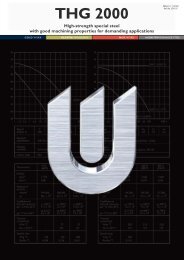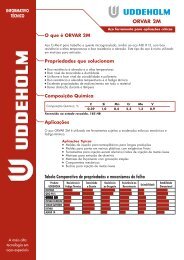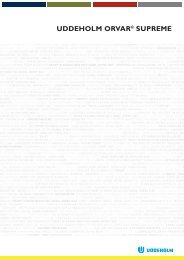VANADIS 60
VANADIS 60
VANADIS 60
Create successful ePaper yourself
Turn your PDF publications into a flip-book with our unique Google optimized e-Paper software.
<strong>VANADIS</strong> <strong>60</strong><br />
High performance powder metallurgical steel for cutting tools
<strong>VANADIS</strong> <strong>60</strong><br />
This information is based on our present state of knowledge and is<br />
intended to provide general notes on our products and their uses.<br />
It should not therefore be construed as a warranty of specific properties of<br />
the products described or a warranty for fitness for a particular purpose.<br />
2
<strong>VANADIS</strong> <strong>60</strong><br />
Applications<br />
<strong>VANADIS</strong> <strong>60</strong> is a premium high alloyed high<br />
performance PM high speed steel with an addition<br />
of cobalt.<br />
<strong>VANADIS</strong> <strong>60</strong> is particularly suitable for single edge<br />
cutting tools where the demands on wear resistance<br />
and hot hardness are very high.<br />
Other applications are cutting tools as taps, end<br />
mills etc. for use in materials very difficult to<br />
machine.<br />
General<br />
<strong>VANADIS</strong> <strong>60</strong> is a W-Mo-V-Co alloyed PM high speed<br />
steel characterized by:<br />
• Highest wear resistance<br />
• Maximum compressive strength<br />
• Good through hardening properties<br />
• Good toughness<br />
• Good dimensional stability on heat treatment<br />
• Superior temper resistance. (Hot hardness)<br />
PHYSICAL DATA<br />
Temperature 20°C 400°C <strong>60</strong>0°C<br />
(68°F) (750°F) (1112°F)<br />
Density,<br />
kg/m 3 (1) 79<strong>60</strong> 78<strong>60</strong> 7810<br />
lbs/in 3 (1) 0,286 0,283 0,281<br />
Modulus of elasticity<br />
MPa (2) 250 000 222 000 200 000<br />
ksi (2) 36 x 10 3 32 x 10 3 20 x 10 3<br />
Coefficient of thermal<br />
expansion per<br />
°C from 20°C (2) – 10,6 x 10 -6 11,1 x 10 -6<br />
°F from 68°F (2) – 5,9 x 10 -6 6,1 x 10 -6<br />
Thermal<br />
conductivity<br />
W/m•°C (2) 21 25 24<br />
Btu in/(ft 2 h°F) (2) 145 173 166<br />
Specific heat<br />
J/kg °C (2) 420 510 <strong>60</strong>0<br />
Btu/lb °F (2) 0,10 0,12 0,14<br />
(1) = for the soft annealed condition.<br />
(2) = for the hardened and tempered condition.<br />
BEND STRENGTH<br />
Typical C Cr Mo W V Co<br />
analysis % 2,3 4,2 7,0 6,5 6,5 10,5<br />
Standard<br />
specification W.-Nr. 1.3241<br />
Delivery<br />
condition<br />
Colour code<br />
Properties<br />
Soft annealed, max. 340 HB<br />
Gold<br />
SPECIAL PROPERTIES<br />
<strong>VANADIS</strong> <strong>60</strong> can be hardened to a very high hardness<br />
and compressive strength. <strong>VANADIS</strong> <strong>60</strong> has<br />
further the same good dimensional stability during<br />
heat treatment as the other <strong>VANADIS</strong> grades. The<br />
toughness is despite the very high alloying content<br />
very good. The machinability is lower compared to<br />
lower alloyed HSS. The grindability of <strong>VANADIS</strong> <strong>60</strong> is<br />
equal or better than other high alloyed HSS, but<br />
somewhat lower than for <strong>VANADIS</strong> 30. <strong>VANADIS</strong> <strong>60</strong><br />
has a very high hot hardness.<br />
Four-point bend testing.<br />
Specimen size: 5 mm (0,2") Ø<br />
Loading rate: 5 mm/min. (0,2"/min.)<br />
Austenitizing temperature: 1100–1210°C (2010–<br />
2210°F)<br />
Tempering: 3 x 1 h at 5<strong>60</strong>°C (1040°F), air cooling to<br />
room temperature.<br />
Load<br />
kN/mm 2<br />
6,0<br />
5,0<br />
4,0<br />
3,0<br />
Rmb<br />
Reb<br />
HRC<br />
70<br />
HRC<br />
65<br />
<strong>60</strong><br />
55<br />
950 1000 1050 1100 1150 1200 1250°C<br />
1740 1830 1920 2010 2100 2190 2280°F<br />
Austenitizing temperature<br />
3
<strong>VANADIS</strong> <strong>60</strong><br />
HIGH TEMPERATURE PROPERTIES<br />
<strong>VANADIS</strong> <strong>60</strong> hot hardness<br />
HRC<br />
68<br />
66<br />
64<br />
1100°C<br />
(2010°F)<br />
Austenitizing temperature<br />
1180°C (21<strong>60</strong>°F)<br />
HV10<br />
1000<br />
900<br />
800<br />
Hardness for different austenitizing temperatures<br />
after tempering 3 times for one hour at 5<strong>60</strong>°C<br />
(±1 HRC).<br />
HRC °C °F<br />
62 9<strong>60</strong> 17<strong>60</strong><br />
64 1000 1832<br />
66 1070 19<strong>60</strong><br />
68 1150 2102<br />
69 1180 2156<br />
<strong>60</strong><br />
700<br />
<strong>60</strong>0<br />
0 200 400 <strong>60</strong>0°C<br />
0 390 750 1110°F<br />
Testing temperature<br />
Recommended holding time<br />
Holding time* min.<br />
15<br />
10<br />
Heat treatment<br />
SOFT ANNEALING<br />
Protect the steel and heat through to 850–900°C<br />
(15<strong>60</strong>–1650°F). Then cool in the furnace at 10°C/h<br />
(20°F/h) to 700°C (1290°F), then freely in air.<br />
STRESS RELIEVING<br />
After rough machining the tool should be heated<br />
through to <strong>60</strong>0–700°C (1110–1290°F), holding time<br />
2 hours. Cool slowly to 500°C (930°F), then freely<br />
in air.<br />
TEMPERING<br />
Pre-heating temperature: 450–500°C (840–930°F)<br />
and 850–900°C (15<strong>60</strong>–1650°F).<br />
Austenitizing temperature: 1100–1180°C, according<br />
to the desired final hardness, see diagram below.<br />
The tool should be protected against decarburization<br />
and oxidation during hardening.<br />
Hardness after tempering 3 times for one hour at<br />
5<strong>60</strong>°C (1040°F).<br />
5<br />
0<br />
1000 1050 1100 1150 °C<br />
1830 1920 2030 2100 °F<br />
Austenitizing temperature<br />
* ) Holding time = time at austenitizing temperature after<br />
the tool is fully heated through.<br />
Total soaking time in a salt bath after pre-heating in<br />
two stages at 450°C (840°F) and 850°C (15<strong>60</strong>°F).<br />
Holding time, min.<br />
40<br />
30<br />
20<br />
10<br />
0<br />
1000°C (1830°F)<br />
1050°C (1920°F)<br />
1100°C (2010°F)<br />
1180°C (21<strong>60</strong>°F)<br />
20 40 <strong>60</strong> 80 100 120 mm<br />
0,79 1,57 2,36 3,15 3,94 4,73 inch<br />
Wall thickness<br />
Final hardness HRC<br />
70<br />
68<br />
66<br />
64<br />
62<br />
980 1020 10<strong>60</strong> 1100 1140 1180°C<br />
1800 1870 1940 2010 2120 21<strong>60</strong>°F<br />
Austenitizing temperature °C<br />
4
<strong>VANADIS</strong> <strong>60</strong><br />
CCT-graph (continuous cooling)<br />
Austenitizing temperature 1150°C (1920°F). Holding time 10 minutes.<br />
°F<br />
2200<br />
2000<br />
°C<br />
1200<br />
1100<br />
Austenitizing temperature 1150°C<br />
Holding time 10 min.<br />
1800<br />
1<strong>60</strong>0<br />
1400<br />
1200<br />
1000<br />
800<br />
<strong>60</strong>0<br />
400<br />
200<br />
1000<br />
900<br />
800<br />
700<br />
<strong>60</strong>0<br />
500<br />
400<br />
300<br />
Carbides<br />
Pearlite<br />
Bainite<br />
200<br />
M s Martensite<br />
1 2 3 4 5 6 7<br />
100<br />
1 10 100 1 000 10 000 100 000 Seconds<br />
A c1f<br />
= 895°C (1640°F)<br />
A c 1s<br />
= 845°C (1553°F)<br />
Hard-<br />
Graph ness T 800–500<br />
No. Hv 10 (sec.)<br />
1 946 1<br />
2 946 28<br />
3 946 140<br />
4 772 630<br />
5 620 1390<br />
6 498 3205<br />
7 450 5215<br />
1 10 100 1 000 Minutes<br />
1 10 100 Hours<br />
Air cooling Air cooling of of bar bar Ø<br />
0,2 1,5 10 90 <strong>60</strong>0<br />
Ø mm<br />
0,0079 0,059 0,394 3,54 23,6<br />
inch<br />
QUENCHING MEDIA<br />
• Martempering bath at approx. 540°C (1004°F)<br />
• Vacuum furnace with high speed gas at sufficient<br />
overpressure.<br />
Note. 1: Quenching should be continued until the<br />
temperature of the tool reaches approx. 25°C<br />
(77°F). The tool should then be tempered immediately.<br />
Note. 2: In order to obtain a high toughness, the<br />
cooling speed in the core should be at least<br />
10°C/sec. (20°F/sec.). This is valid for cooling from<br />
the austenitizing temperature down to approx.<br />
540°C (1004°F). After temperature equalization<br />
between the surface and core, the cooling rate of<br />
approx. 5°C/sec. (10°F/sec.) can be used. The above<br />
cooling cycle results in less distortion and residual<br />
stresses.<br />
TEMPERING<br />
Tempering should normally be carried out at 5<strong>60</strong>°C<br />
(1040°F) irrespective of the austenitizing temperature.<br />
Temper three times for one hour at full temperature.<br />
The tool should be cooled to room temperature<br />
between the tempers. The retained austenite<br />
content will be less than 1% after this tempering<br />
cycle.<br />
DIMENSIONAL CHANGES<br />
Dimensional changes after hardening and tempering.<br />
Heat treatment: austenitizing between 1050–<br />
1130°C (1920–2070°F) and tempering 3 x 1 h at<br />
5<strong>60</strong>°C (1040°F).<br />
Specimen size: 80 x 80 x 80 mm (2,91 x 2,91 x 2,91 in.)<br />
and 100 x 100 x 25 mm (3,94 x 3,94 x 0,99 in.).<br />
Dimensional changes: growth in length, width and<br />
thickness: +0,03% to +0,13%.<br />
Some guidelines for<br />
hardening<br />
<strong>VANADIS</strong> <strong>60</strong><br />
Tool Hardening Tempering HRC<br />
3 times<br />
Single-edge cutting tools:<br />
tool bits 1190°C 550°C 68–70<br />
2175°F 1025°F<br />
Form tools 1180°C 5<strong>60</strong>°C 67–68<br />
2155°F 1040°F<br />
Rotating multi-edge cutting<br />
tools:<br />
twist drills, milling cutters,<br />
broaches, taps, hobs, shaper<br />
cutters, etc. 1150–1180°C 5<strong>60</strong>°C 66–68<br />
2100–2155°F 1040°F<br />
5
<strong>VANADIS</strong> <strong>60</strong><br />
Cutting data<br />
recommendations<br />
The cutting data below are to be considered as<br />
guiding values which must be adapted to existing<br />
local conditions. More information can be found in<br />
the Uddeholm publication “Cutting data recommendation”.<br />
Condition: Soft annealed to approx. 300 HB<br />
TURNING<br />
Turning with carbide Turning<br />
with HSS<br />
Cutting data Rough Fine Fine<br />
parameters turning turning turning<br />
Cutting<br />
speed (v c )<br />
m/min <strong>60</strong>–90 90–110 6–10<br />
f.p.m. 200–300 300–365 20–33<br />
Feed (f)<br />
mm/r 0,2–0,4 0,05–0,2 0,05–0,3<br />
i.p.r. 0,008–0,016 0,002–0,008 0,002–0,012<br />
Depth of cut (a p )<br />
mm 2–4 0,5–2 0,5–3<br />
inch 0,08–0,16 0,02–0,08 0,02–0,12<br />
Carbide K20,<br />
designation ISO P10–P20 K15, P10 –<br />
Coated Coated<br />
carbide* carbide*<br />
* Use a wear resistant Al 2 O 3 -coated carbide<br />
DRILLING<br />
High speed steel twist drill<br />
Drill diameter Cutting speed v c Feed f<br />
mm inch m/min. f.p.m. mm/r i.p.r.<br />
– 5 –3/16 6–8* 20–26* 0,05–0,10 0,002–0,004<br />
5–10 3/16–3/8 6–8* 20–26* 0,10–0,20 0,004–0,008<br />
10–15 3|8–5|8 6–8* 20–26* 0,20–0,25 0,008–0,010<br />
15–20 5|8–3|4 6–8* 20–26* 0,25–0,30 0,010–0,012<br />
* For coated HSS drill v c<br />
= 12–14 m/min. (39–46 f.p.m.)<br />
Carbide drill<br />
Type of drill<br />
Cutting data Indexable Solid Brazed<br />
parameters insert carbide carbide 1)<br />
Cutting<br />
speed, v c<br />
m/min 80–100 40–<strong>60</strong> 20–30<br />
f.p.m. 265–335 131–199 66–98<br />
Feed, f<br />
mm/r 0,05–0,15 2) 0,10–0,15 2) 0,10–0,20 2)<br />
i.p.r. 0,002–0,006 2) 0,004–0,006 2) 0,004–0,008 2)<br />
1)<br />
Drill with internal cooling channels and brazed tip.<br />
2)<br />
Depending on drill diameter.<br />
MILLING<br />
Face and square shoulder milling<br />
Milling with carbide<br />
Cutting data<br />
parameters Rough milling Fine milling<br />
Cutting speed (v c )<br />
m/min 40–<strong>60</strong> <strong>60</strong>–80<br />
f.p.m. 135–200 200–265<br />
Feed (f z )<br />
mm/tooth 0,2–0,4 0,1–0,2<br />
inch/tooth 0,008–0,016 0,004–0,008<br />
Depth of cut (a p )<br />
mm 2–4 1–2<br />
inch 0,08–0,16 0,04–0,08<br />
Carbide<br />
designation ISO K20–P20 K15–P15<br />
Coated carbide* Coated carbide*<br />
or cermet<br />
* Use a wear resistant Al 2 O 3 -coated carbide<br />
End milling<br />
Type of mill<br />
Carbide TiCN coated<br />
Cutting data Solid indexable high speed<br />
parameters carbide insert steel<br />
Cutting<br />
speed (v c )<br />
m/min 30–40 40–<strong>60</strong> 10–14<br />
f.p.m. 100–131 135–200 33–46<br />
Feed (f z )<br />
mm/tooth 0,01–0,2 1) 0,06–0,2 1) 0,01–0,3 1)<br />
inch/tooth 0,0004–0,008 1) 0,002–0,008 1) 0,0004–0,012 1)<br />
Carbide<br />
designation<br />
ISO – K15, P10–P20 –<br />
Coated carbide 2)<br />
1)<br />
Depending on radial depth of cut and cutter diameter<br />
2)<br />
Use a wear resistant Al 2 O 3 -coated carbide<br />
GRINDING<br />
General grinding wheel recommendation is given<br />
below. More information can be found in the<br />
Uddeholm publication “Grinding of Tool Steel”.<br />
Soft annealed Hardened<br />
Type of grinding condition condition<br />
Face grinding A 46 HV B151 R50 B3 1)<br />
straight wheel A 46 GV 2)<br />
Face grinding A 36 GV A 46 GV<br />
segments<br />
Cylindrical A <strong>60</strong> KV B151 R50 B3 1)<br />
grinding A <strong>60</strong> JV 2)<br />
Internal grinding A <strong>60</strong> JV B151 R75 B3 1)<br />
A <strong>60</strong> IV<br />
Profile grinding A 100 IV B126 R100 B6 1)<br />
A 100 JV 2)<br />
1)<br />
If possible, use CBN wheels for this application<br />
2)<br />
Preferable a wheel type containing sintered Al 2 O 3 (seeded gel)<br />
6
<strong>VANADIS</strong> <strong>60</strong><br />
EDM<br />
If EDM is performed in the hardened and tempered<br />
condition, finish with “finesparking”, i.e. low<br />
current, high frequency. For optimal performance<br />
the EDM’d surface should then be ground/polished<br />
and the tool retempered at approx. 535°C (995°F).<br />
Relative comparison of Uddeholm PM steels<br />
MATERIAL PROPERTIES AND RESISTANCE TO FAILURE MECHANISMS<br />
Hardness/ Resistance to Fatigue cracking resistance<br />
Resistance<br />
Ductility/<br />
Uddeholm to plastic Machin- Grind- Dimension Abrasive Adhesive resistance to Hot<br />
grade deformation ability ability stability wear wear chipping hardness<br />
<strong>VANADIS</strong> 23<br />
<strong>VANADIS</strong> 30<br />
<strong>VANADIS</strong> <strong>60</strong><br />
AISI M:2<br />
AISI M35<br />
Further information<br />
Please, contact your local Uddeholm office for<br />
further information on the selection, heat treatment,<br />
application and availability of Uddeholm tool steels.<br />
7


